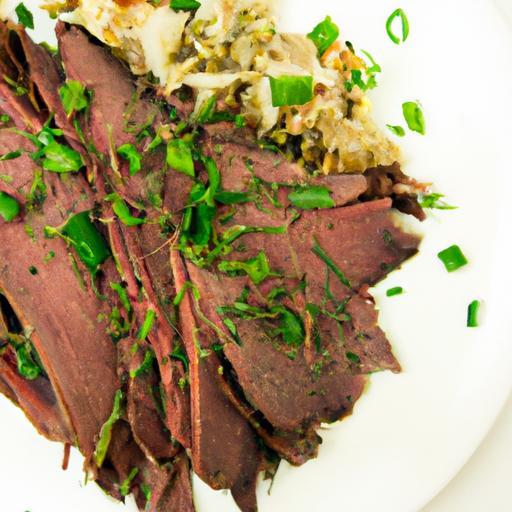There’s an elusive magic that transforms a humble brisket from a simple cut of meat into a smoky masterpiece-its bark. That dark, crusty exterior, rich with layers of flavor and texture, holds the secret to barbecue bliss. But achieving the perfect brisket bark isn’t merely luck; it’s a careful dance of timing, technique, and the right ingredients. In this article, we’ll unlock the mysteries behind crafting that coveted crust, revealing expert tips to elevate your brisket from good to unforgettable. Prepare to embark on a flavorful journey where science meets tradition, and every bite tells a smoky story.
Unlocking the perfect brisket bark begins with understanding the delicate interplay of ingredients, smoking methods, and post-cook care that create that irresistible crust. This savory, caramelized layer is where flavor intensifies, texture crisps, and every bite sings with smoky delight. As a smoker’s crowning glory, the brisket bark is more than just a look – it’s a tactile experience that elevates the entire dish to new heights.
Prep and Cook Time
- Preparation: 30 minutes
- Smoking: 8-12 hours (depending on brisket size and smoker)
- Resting: 1 hour
- Total Time: Approximately 10-14 hours
Yield
Serves 8-10 people, ideal for gatherings and hearty meals.
Difficulty Level
Advanced: Requires patience, attention to detail, and smoking technique mastery.
Ingredients
- 1 whole packer brisket (10-14 lbs), trimmed with 1/4-inch fat cap
- 1/4 cup kosher salt
- 1/4 cup coarse black pepper, freshly ground
- 2 tbsp smoked paprika
- 1 tbsp garlic powder
- 1 tbsp onion powder
- 2 tsp cayenne pepper (optional for heat)
- 2 tbsp brown sugar (for subtle sweetness)
- Wood chunks for smoking: oak, hickory, or pecan
- Vegetable oil or mustard (for binding rub)
Instructions
- Trim the brisket: Remove silver skin and excess fat from the meat side, leaving about 1/4-inch fat cap on top to protect during smoking.
- Prepare the rub: In a bowl, combine kosher salt, black pepper, smoked paprika, garlic powder, onion powder, cayenne, and brown sugar. Blend until evenly mixed.
- Apply a binder: Lightly coat the entire brisket with mustard or vegetable oil to help the rub adhere and encourage crust formation.
- Generously season: Rub every inch of the brisket with the spice mix. Press firmly to ensure it sticks well, focusing on the fat cap for bark development.
- Preheat your smoker: Set to 225°F (107°C) using your choice of wood chunks (oak and hickory offer robust, smoky flavor; pecan adds a mild sweetness).
- Smoke low and slow: Place the brisket fat side up on the smoker rack. Maintain a steady temperature between 225-250°F. Resist the urge to open often-every peek lets out precious heat and smoke.
- Monitor internal temperature: After 6-8 hours, begin checking internal temp using a probe. Target 195-205°F for ideal tenderness and bark formation.
- Spritz periodically: Every hour or two, lightly mist the brisket with apple cider vinegar or a mix of apple juice and water to keep the surface moist, aiding the Maillard reaction essential for bark.
- Wrap at the stall (optional): Once internal temp hits 160-170°F and bark is well-formed, wrap brisket tightly in butcher paper or foil to push through the stall without compromising crust integrity.
- Rest the brisket: After removal, let your meat rest wrapped for at least 1 hour at room temperature. Resting redistributes juices and firms the bark texture.
- Enhance the bark: Unwrap and, if needed, place brisket back in the smoker at 225°F without foil for an additional 20-30 minutes to crisp up any softened bark spots.
Tips for Success
- Salt and pepper ratio: Classic Texas-style brisket bark relies heavily on kosher salt and coarse black pepper for a robust crust. Don’t skimp on these.
- Patience is key: Avoid the temptation to increase smoker temperature to speed cooking; low and slow maximizes bark quality and tenderness.
- Experiment with wood: Each wood type imparts unique smoke characteristics-personalize your profile by blending woods or switching per cook.
- Surface moisture balance: Avoid over-spritzing-the goal is a lightly moist surface, not saturated, to promote caramelization and bark crust.
- Make ahead: You can prepare your rub mix days in advance and apply the night before smoking for deeper flavor penetration.
Serving Suggestions
Slice brisket thin against the grain to showcase the smoky bark alongside tender interior. Serve with pickled jalapeños, tangy barbecue sauce, and a side of smoked baked beans. Garnish plates with fresh chopped cilantro or scallions for a color pop and fresh herb aroma that contrasts the rich bark. This brisket pairs perfectly with creamy coleslaw or charred grilled corn, creating a balanced flavor experience.

Nutrition Information (per serving)
| Calories | Protein | Carbs | Fat |
|---|---|---|---|
| 450 | 38g | 4g | 30g |
For deeper skills on smoking techniques for beginners, explore our detailed guide. For scientific insight on Maillard reactions critical to bark formation, refer to this ScienceDaily article.
Q&A
Q: What exactly is a brisket bark, and why is it important?
A: Think of brisket bark as the flavorful, crispy crust that forms on the outside of your smoked brisket. It’s a magical marriage of seasoning, smoke, and caramelization that locks in juices and delivers that mouthwatering texture and deep flavor contrast everyone craves. Without a good bark, your brisket might taste one-dimensional and miss that smoky punch.
Q: How can I ensure my brisket develops the perfect bark?
A: The secret starts with preparation and patience! First, generously apply a dry rub with plenty of salt, pepper, and spices that promote crust formation. Then, maintain consistent low-and-slow smoking temperatures (225°F to 250°F) to allow the bark to develop gradually. Avoid opening the smoker frequently, and resist wrapping too early so the bark can properly set.
Q: Does the type of wood affect the bark?
A: Absolutely! The wood you choose not only influences the overall flavor but also the texture of the bark. Woods like oak, hickory, and mesquite create a bold smoke flavor that enhances the crust’s complexity, while fruitwoods like apple or cherry add a sweeter, milder smoke that can deepen the bark’s color and aroma. Experiment to find your perfect smoke symphony.
Q: Should I use a mop or spritz during smoking?
A: Spritzing can be your friend, but it’s a delicate dance. A light spritz (usually apple juice or vinegar-based) every hour or so adds moisture and helps develop that beautiful bark without washing away your seasoning. Overdoing it? That’s a bark killer, leaving you with a soggy, pale crust.
Q: Can resting the brisket affect the bark?
A: Resting is crucial-not just for juicy meat but for bark perfection. Let your brisket rest wrapped loosely in butcher paper or foil for at least 30 minutes post-smoke to let the juices redistribute without steaming the bark. This way, your bark stays crisp and flavorful, ready to deliver that irresistible first bite.
Q: Any last pro tips for bark bliss?
A: Yes! Don’t underestimate the power of seasoning timing-apply your rub the night before to let flavors penetrate deeply. Also, consider a thin layer of mustard or oil as a binder for the rub-it won’t taste like mustard but will help your bark hold tight. And remember, every brisket is unique-embrace the journey and tweak your method until you unlock your legendary bark!
To Conclude
As you embark on your journey to unlock the perfect brisket bark, remember that patience, attention to detail, and a little culinary curiosity are your best allies. The crust that crowns your brisket is more than just a flavorful exterior-it’s a testament to the art of barbecue, a symphony of textures and tastes that elevates every bite. By mastering the balance of seasoning, smoke, and heat, you transform humble ingredients into a show-stopping centerpiece that delights the senses. So fire up your smoker, dust off your rubs, and embrace the process-flavor bliss is just a bark away.


